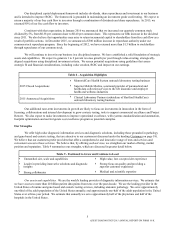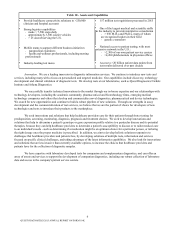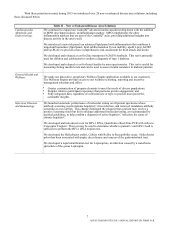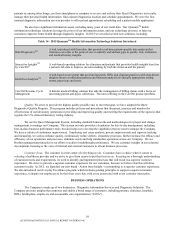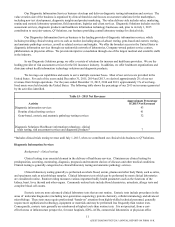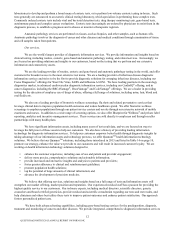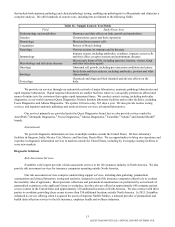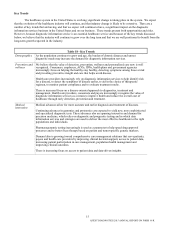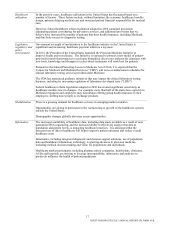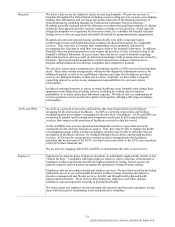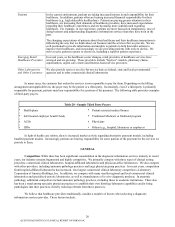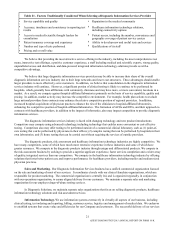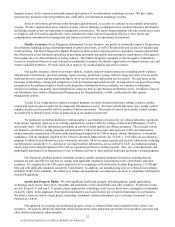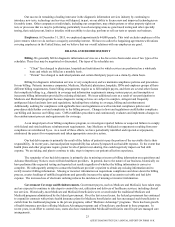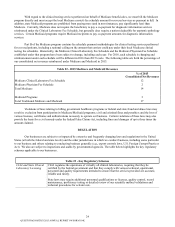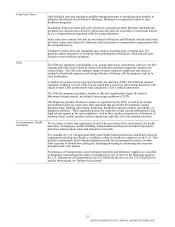Quest Diagnostics 2015 Annual Report Download - page 19
Download and view the complete annual report
Please find page 19 of the 2015 Quest Diagnostics annual report below. You can navigate through the pages in the report by either clicking on the pages listed below, or by using the keyword search tool below to find specific information within the annual report.
15
Key Trends
The healthcare system in the United States is evolving; significant change is taking place in the system. We expect
that the evolution of the healthcare industry will continue, and that industry change is likely to be extensive. There are a
number of key trends that are having, and that we expect will continue to have, a significant impact on the diagnostic
information services business in the United States and on our business. These trends present both opportunities and risks.
However, because diagnostic information service is an essential healthcare service and because of the key trends discussed
below, we believe that the industry will continue to grow over the long term and that we are well positioned to benefit from the
long-term growth expected in the industry.
Table 18 - Key Trends
Demographics As the population continues to grow and age, the burden of chronic diseases and unmet
diagnostic needs may increase the demand for diagnostic information services.
Prevention and
wellness We believe that the value of detection, prevention, wellness and personalized care now is well
recognized. Consumers, employers, ACOs, IDNs, health plans and government agencies
increasingly focus on helping the healthy stay healthy, detecting symptoms among those at risk
and providing preventive insight and care that helps avoid disease.
Health care providers increasingly rely on diagnostic information services to help identify risk
for a disease, to detect the symptoms of disease earlier, to aid in the choice of therapeutic
regimen, to monitor patient compliance and to evaluate treatment results.
There is increased focus on a disease-oriented approach to diagnostics, treatment and
management. Health care providers, consumers and payers increasingly recognize the value of
diagnostic information services as a means to improve health and reduce the overall cost of
healthcare through early detection, prevention and treatment.
Medical
innovation Medical advances allow for more accurate and earlier diagnosis and treatment of diseases.
Continuing advances in genomics and proteomics are expected to yield new, more sophisticated
and specialized diagnostic tests. These advances also are spurring interest in and demand for
precision medicine, which relies on diagnostic and prognostic testing and in which data
information services and strategies are used to deliver the most effective healthcare to the right
populations and individuals.
Pharmacogenomic testing increasingly is used as a parameter to help speed drug approval
processes and to better focus therapy based on patient and tumor-specific genetic markers.
Demand also is growing toward comprehensive care management solutions that serve patients,
payers and health care providers by improving clinical decision support, access to patient data,
increasing patient participation in care management, population health management and
improving clinical outcomes.
There is increasing focus on access to patient data and data-driven insights.
QUEST DIAGNOSTICS 2015 ANNUAL REPORT ON FORM 10-K


